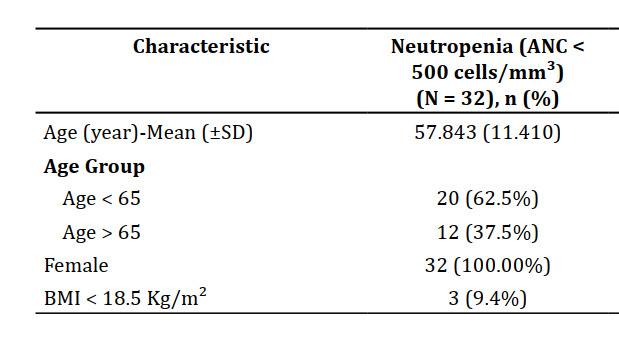PREVALENCE AND PREDICTIVE FACTORS OF NEUTROPENIA AMONG PATIENTS WITH BREAST CANCER RECEIVING DOXORUBICINCYCLOPHOSPHAMIDE CHEMOTHERAPY AT A CANCER CENTER, SURIN HOSPITAL: A RETROSPECTIVE CASE-CONTROL STUDY
DOI:
https://doi.org/10.55374/jseamed.v8.201Keywords:
breast cancer, anthracycline, anticancer treatment, neutropeniaAbstract
Background: Despite significant advancements in breast cancer treatment with targeted therapy and immunotherapy, chemotherapy remains a crucial component across all stages. Anthracycline-based chemotherapy, while commonly administered, can lead to severe and potentially fatal complications such as febrile neutropenia.
Objectives: This study aimed to investigate the prevalence and predictive factors for developing neutropenia in patients with breast cancer undergoing an anthracycline-based chemotherapy regimen.
Methods: A retrospective case-control study was conducted at the Surin Hospital Cancer Center from January 2020 to December 2022. It focused on patients diagnosed with breast cancer and treated with anthracycline-based chemotherapy, specifically the doxorubicin-cyclophosphamide regimen (AC). Prognostic factors were analyzed using a flexible parametric regression model, employing univariate and multivariate analyses.
Results: A total of 174 eligible patients with confirmed breast cancer who received AC regimen chemotherapy were included; 99.4% were predominantly female, with 21.7% being over 65 and nearly 40% having at least one other health condition. Neutropenia, characterized by a neutrophil count of less than 500 cells/mm3, was observed among 18% of patients. Of these, 4% developed febrile neutropenia, resulting in two deaths. A multivariate analysis identified two factors, age of 65 years or older (adjusted OR=3.18; 95% CI 1.122-9.013; p=0.029) and an initial absolute neutrophil count less than 3,000 cells/mm3 (adjusted OR=2.73; 95% CI 1.032-7.204; p=0.043), as independent predictors of neutropenia. Interestingly, the severity of neutropenia did not significantly differ between patients with or without additional health conditions or varying nutritional statuses.
Conclusion: As anticipated, a significant prevalence of neutropenia was observed among individuals with breast cancer, underscoring the critical importance of age and initial neutrophil count in predicting the severity of neutropenic incidents. These findings offer valuable insights for tailoring treatment strategies and optimizing patient care in this clinical context.
Downloads
Metrics
References
Gradishar WJ, Moran MS, Abraham J, Abramson V, Aft R, Agnese D, et al. NCCN Guidelines® Insights: Breast Cancer, Version 4.2023. J Natl Compr Canc Netw 2023; 21: 594-608. https://doi.org/10.6004/jnccn.2023.0031 DOI: https://doi.org/10.6004/jnccn.2023.0031
Hayes DF, Lippman ME. Breast cancer, Section 1 Neoplastic disorder, Part 4 Oncology and Hematology. In: Harrison's Principles of Internal Medicine, 20th Edition. New York, NY: McGraw-Hill Education; 2018. Pages 555-65.
Sausville EA, Longo DL. Principles of cancer treatment. Section 1 Neoplastic disorder, PART 4 oncology and hematology. In: Harrison's Principles of Internal Medicine, 20th Edition. New York, NY: McGraw-Hill Education; 2018. Pages 480-501.
Kuderer NM, Dale DC, Crawford J, Cosler LE, Lyman GH. Mortality, morbidity, and cost associated with febrile neutropenia in adult cancer patients. Cancer 2006; 106: 2258-66. https://doi.org/10.1002/cncr.21847 DOI: https://doi.org/10.1002/cncr.21847
Chan A, Chen C, Chiang J, Tan SH, Ng R. Incidence of febrile neutropenia among early-stage breast cancer patients receiving anthracycline-based chemotherapy. Support Care Cancer 2012; 20: 1525-32. https://doi.org/10.1007/s00520-011-1241-6
Kim HS, Lee SY, Kim JW, Choi YJ, Park IH, Lee KS, et al. Incidence and predictors of febrile neutropenia among early-stage breast cancer patients receiving anthracyclinebased chemotherapy in Korea. Oncology. 2016; 91: 274-82. https://doi.org/10.1159/000449226 DOI: https://doi.org/10.1159/000449226
Min SY, Baek SK, Maeng CH, Han JJ, Kim HJ. Risk factor of febrile neutropenia in early breast cancer patients receiving anthracycline-based chemotherapy. Clin Oncol 2020; 5: 1763.
Schwartz J, Domchek SM, Hwang WT, Fox K. Evaluation of anemia, neutropenia and skin toxicities in standard or dose-dense doxorubicin/cyclophosphamide (AC)-paclitaxel or docetaxel adjuvant chemotherapy in breast cancer. Ann Oncol 2005; 16: 247-52. https://doi.org/10.1093/annonc/mdi058 DOI: https://doi.org/10.1093/annonc/mdi058
Chan A, Chen C, Chiang J, Tan SH, Ng R. Incidence of febrile neutropenia among early-stage breast cancer patients receiving anthracycline-based chemotherapy. Support Care Cancer 2012; 20: 1525-32. https://doi.org/10.1007/s00520-011-1241-6 DOI: https://doi.org/10.1007/s00520-011-1241-6
Lyman GH, Michels SL, Reynolds MW, Barron R, Tomic KS, Yu J. Risk of mortality in patients with cancer who experience febrile neutropenia. Cancer 2010; 116: 5555-63. https://doi.org/10.1002/cncr.25332 DOI: https://doi.org/10.1002/cncr.25332
Moreau M, Klastersky J, Schwarzbold A, Muanza F, Georgala A, Aoun M, et al. A general chemotherapy myelotoxicity score to predict febrile neutropenia in hematological malignancies. Ann Oncol 2009; 20: 513-9. https://doi.org/10.1093/annonc/mdn655 DOI: https://doi.org/10.1093/annonc/mdn655
Chow LWC, Biganzoli L, Leo AD, Kuroi K, Han HS, Patel J, et al. Toxicity profile differences of adjuvant docetaxel/cyclophosphamide (TC) between Asian and Caucasian breast cancer patients. Asia Pac J Clin Oncol 2017; 13: 372-78. https://doi.org/10.1111/ajco.12682 DOI: https://doi.org/10.1111/ajco.12682
Berry DA, Cronin KA, Plevritis SK, Fryback DG, Clarke L, Zelen M, et al. Cancer Intervention and Surveillance Modeling Network (CISNET) Collaborators. Effect of screening and adjuvant therapy on mortality from breast cancer. N Engl J Med 2005; 353: 1784-92. https://doi.org/10.1056/NEJMoa050518 DOI: https://doi.org/10.1056/NEJMoa050518
Geiger H, Van Zant G. The aging of lymphohematopoietic stem cells. Nat Immunol 2002; 3: 329-33. https://doi.org/10.1038/ni0402-329 DOI: https://doi.org/10.1038/ni0402-329
DeVita VT Lawrence TS Rosenberg SA. Devita Hellman and Rosenberg's Cancer : Principles & Practice of Oncology. 8th ed. Wolters Kluwer/Lippincott Williams & Wilkins; 2008.
Pizzo PA. Management of fever in patients with cancer and treatment-induced neutropenia. N Engl J Med 1993; 328: 1323-32. https://doi.org/10.1056/NEJM199305063281808 DOI: https://doi.org/10.1056/NEJM199305063281808

Downloads
Published
How to Cite
Issue
Section
License
Copyright (c) 2024 Journal of Southeast Asian Medical Research

This work is licensed under a Creative Commons Attribution-NonCommercial-NoDerivatives 4.0 International License.
The Journal of Southeast Asian Medical Research will hold the copyright to all published articles. The publisher's production department handles copyright forms once a manuscript is accepted and scheduled for publication.







